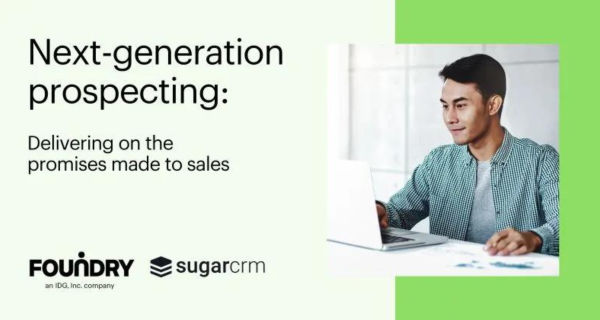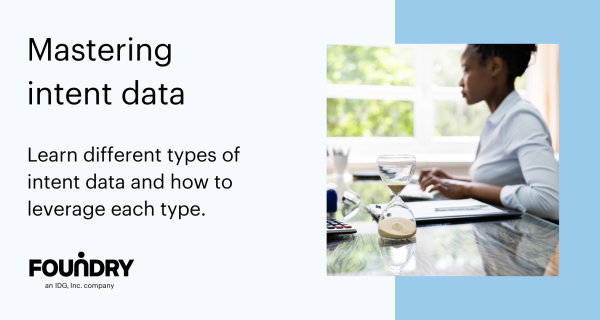Psychologists say it only takes 7 seconds to make a first impression, and nobody recognizes the importance of first impressions more than salespeople. However, with today’s intent data and machine learning, sales teams are making first impressions well before jumping on a call with prospects. First impressions can and should be built long before the initial conversation with buyers.
“In sales, sometimes we only get one chance or even one moment. Intent data gives us the insight to know exactly which product or service to present to the buyer. Without intent data, you could easily strike out if you present the wrong offering,”
Tina Bean, VP of Product Development at Foundry.
Three ways to activate your intent data
In the context of account-based marketing, intent data is based on account activity and whether or not an account is showing purchase intent. Marketing and sales teams gather first-party intent data from unmasked website activity, leads matched to accounts, and sales engagement. In addition to third-party intent data – from product review websites, Google searches, analyst white papers, event attendance, and video views all help create a more complete picture of accounts moving through the buyer journey.
Each set of intent data helps identify the buyer’s purchase behavior and equips sales to activate relevant sales plays. This curates a highly targeted approach for B2B organizations when engaging with likely buyers – ultimately, wasting less valuable time and money for the organization.
Let’s cover three ways sales teams utilize intent data to stay ahead of the competition.
1. Competitive box-out
While selecting third-party intent topics, we suggest including your competitors. Think basketball: a competitor shoots their shot at a prospect, but with intent data sales teams are able to anticipate the shot, grab the rebound, and put the ball back on your side of the court. Knowing when buyers are looking at your competitors is extremely helpful during the sales process. It allows you to anticipate which questions buyers will have in the next meeting based on which competitors they’re looking at.
This enables reps to make competitive counterclaims on multiple channels and prepare for ensuing conversations with prospective buyers. For example, sales, armed with customer stories promising a better-fit solution over a competitor makes for a more persuasive sales play. Foundry Jared McGlotten shared his experience leveraging intent to close competitive deals.
“In these situations, I’ve used Foundry intent sources to determine the vendor that was also vying for the business and then appropriately position myself against the vendor to secure a win. Without any intent data at my disposal, I wouldn’t have known who else was present in the deal which would have resulted in an opportunity loss as opposed to a win,” said McGlotten.
Jared McGlotten, Strategic Account Executive at Foundry
Showing buyers why other organizations chose your solution over the competition resonates more than aimless claims. Sales and marketing can also provide air coverage ads reinforcing competitive messaging and web personalization with relevant counterclaim content consistent with sales messaging.
2. 1:1 personalized landing pages
Another method for getting the most out of your intent signals is creating highly personalized landing pages with content to address prospect pain points. 1:1 Landing pages can
By using intent data to create 1:1 landing pages, you can nurture accounts with tailored content to their needs and provide a valuable resource for prospects throughout the buyer’s journey.
For example, SmartPages allow marketing and sales teams to create 1:1 landing pages for accounts at scale that are customized to the needs, interests, and buying profile of each account in an account list of any size.
3. Focused interest & concerns
This method utilizes first-party intent data to identify specific areas of focused interest or concern. Once deeper within the buying cycle, the prospect begins to focus on more specific areas of interest or concern. By knowing and speaking to these more specific topics, sales reps gain a clear advantage when addressing these concerns in conversation with prospects.
“Being able to drill down on specific areas of interest or concern based on first-party intent data can be a force multiplier in the selling process,”
Andre Yee, Triblio Founder
Conclusion
Top sales leaders have been using intent data and adopting these strategies for quite some time. Utilizing intent data is becoming the norm for B2B organizations. According to a Gartner Emerging Technology Analysis, by the end of 2022, more than 70% of B2B marketers will use intent data to amplify their ABM strategies. And for good reason, according to a study by InboxInsights, “99% of respondents attest intent data to either ROI increase, conversion growth, or a combination of both,” (Inside Intent Data, 2020)
The information to create more revenue opportunities, close more deals, and have a positive ROI is available. What separates the great from the good B2B sales organizations is the ability to act upon purchase signals and strike while the iron is hot.
Stay tuned for our next blog in the sales series discussing how Chief Revenue Officers can shorten B2B sales cycles by implementing the latest ABM technology and tracking the right metrics.




